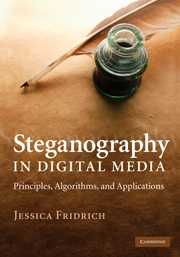Book contents
- Frontmatter
- Dedication
- Contents
- Preface
- Acknowledgments
- 1 Introduction
- 2 Digital image formats
- 3 Digital image acquisition
- 4 Steganographic channel
- 5 Naive steganography
- 6 Steganographic security
- 7 Practical steganographic methods
- 8 Matrix embedding
- 9 Non-shared selection channel
- 10 Steganalysis
- 11 Selected targeted attacks
- 12 Blind steganalysis
- 13 Steganographic capacity
- A Statistics
- B Information theory
- C Linear codes
- D Signal detection and estimation
- E Support vector machines
- Notation and symbols
- Glossary
- References
- Index
- Plate section
6 - Steganographic security
Published online by Cambridge University Press: 05 April 2014
- Frontmatter
- Dedication
- Contents
- Preface
- Acknowledgments
- 1 Introduction
- 2 Digital image formats
- 3 Digital image acquisition
- 4 Steganographic channel
- 5 Naive steganography
- 6 Steganographic security
- 7 Practical steganographic methods
- 8 Matrix embedding
- 9 Non-shared selection channel
- 10 Steganalysis
- 11 Selected targeted attacks
- 12 Blind steganalysis
- 13 Steganographic capacity
- A Statistics
- B Information theory
- C Linear codes
- D Signal detection and estimation
- E Support vector machines
- Notation and symbols
- Glossary
- References
- Index
- Plate section
Summary
In the previous chapter, we saw a few examples of simple steganographic schemes and successful attacks on them. We learned that the steganographic scheme called LSB embedding leaves a characteristic imprint on the image histogram that does not occur in natural images. This observation lead to an algorithm (a detector) that could decide whether or not an image contains a secret message. The existence of such a detector means that LSB embedding is not secure. We expect that for a truly secure steganography it should be impossible to construct a detector that could distinguish between cover and stego images. Even though this statement appears reasonable at first sight, it is vague and allows subjective interpretations. For example, it is not clear what is meant by “could distinguish between cover and stego images.” We cannot construct a detector that will always be 100% correct because it is hardly possible to detect the effects of flipping one LSB, at least not reliably in every cover. Just how reliable must a detector be to pronounce a steganographic method insecure?
Even though there are no simple practical solutions to the questions raised in the previous paragraph, they can in principle be studied within the framework of information theory. Imagine that Alice and Bob are engaging in a legitimate communication and do not use steganography. Let us suppose that they exchange grayscale 512 × 512 images in raster format that were never compressed.
Information
- Type
- Chapter
- Information
- Steganography in Digital MediaPrinciples, Algorithms, and Applications, pp. 81 - 106Publisher: Cambridge University PressPrint publication year: 2009
